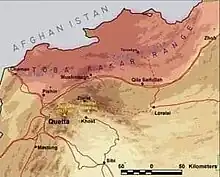The Kingdom of Kaikan (alternatively Kikan, Kiknan, Qaiqan or Qayqan) was a Jat kingdom in present-day Pakistan.[1] It played an important role in protecting Sindh from Arab invasions. During the reign of the Khalifa Al-Mutasim, Arabs annexed this region successfully after defeating Jats.
| Arab conquest of Kaikan | |||||||||
|---|---|---|---|---|---|---|---|---|---|
| Part of Umayyad conquest of Sindh | |||||||||
 Kaikan mountain ranges | |||||||||
| |||||||||
| Belligerents | |||||||||
|
Rashidun Caliphate Umayyad Caliphate | Jats of Kaikan | ||||||||
| Commanders and leaders | |||||||||
|
Imran bin Musa al Barmaki Abdallah ibn Sawwar al-Abdi Harith ibn Murrah al-Abdi | Unknown | ||||||||
| Casualties and losses | |||||||||
| Unknown | 27,000 Jats taken as prisoners. | ||||||||
History
.jpg.webp)
Kaikan, named after a mountain, was a small province in Sindh near the Bolan Pass.
The first raid is noted by Al-Baladhuri, Ibn Sa'd and Khalifah ibn Khayyat to have taken place in 658 AD. Kaikan was written as al-Qiqan by them and located near Quetta. Harith ibn Murrah al-Abdi and Sayfi ibn Fil al-Shaybani participated in this raid.[2]
The fourth Khalifa Ali sent the 2nd expedition to Sindh under Harith ibn Murrah al-Abdi in 660 (according to Al-Baladhuri). However, the Chach Nama says Saghar bin Zuar had been appointed, not Harith.
After a successful raid in Sindh in 662, Harith turned his attention to Kaikan. Harith had outfitted a formidable Muslim army with nobles and chiefs. This army encountered no real opposition till it reached the treacherous terrain of Kaikan. The Jats & Meds (Meds/Mers) put up a tough fight against the Arabian invaders and decisively repulsed the attack.[3] Harith along with his followers was killed in this battle in the year 42 AH (662 AD).[4] In an extraordinary battle, the Jats repelled them,[5] outclassing a vastly superior military force; superior in number, training, equipment and war experience. Only a handful of the large army could retreat & report the disaster to the Caliph. The casualties on the Jat side were quite significant but the Arab invaders had been decisively repulsed. This was a huge blow to the Caliph, and so, for the next twenty years, every successive Caliph made Kaikan a special target for conquest and sent as many as six expeditions, five of which failed to make any permanent impact in Sindh.[2]
The Emir Abd Allah ibn Amir, or the Khalifa Mu'awiya I himself, are said to have sent Abdallah ibn Sawwar al-Abdi to Sindh. He is said to have fought in Kaikan & captured some spoils, although the outcome of the battle isn't given.[6]
Ziyad ibn Abihi (Ziyad ibn Abu-Sufian), during the reign of Mu'awiya I, appointed Rashid ibn Omar al-Judaidi, a member of the Azd tribe, to the frontiers of Sindh. He was the first Arab to win a battle against Kaikan, but was killed by the Meds.[2]
Ziyad then appointed al-Manzar (also spelt al-Mundhir) ibn al-Jarud al-Abdi (Abu-l-Ash’as) to Sindh. al-Manzar is said to have conquered Kaikan.[7]
When Muhammad bin Qasim (694-715) invaded Sindh, the Kaikan country was the independent possession of the Jats.[8] The country of Kaikan was supposed to be to the south-east of Afghanistan, which was conquered from the Jats by Arab general Imran bin Musa al Barmaki (son of Musa ibn Yahya) during the reign of the Khalifa Al-Mutasim-bi-llah (833-881). During his reign another expedition was sent against the Jats who had seized the roads to Hajar, spread terror there and set up posts in all directions towards the desert. They were overcome after a bloody conflict lasting twenty five days. 27,000 of them were held in captivity as a celebration of the Arab victory. It was a custom among these people to blow their horns when marshalled for battle.[9][10]
See also
References
- ↑ Barve, Shashikant V. (1995). Introduction to Classical Arabic: A Contribution to Islamic and Oriental Studies. S.V. Barve. p. 451.
- 1 2 3 Islam, Arshad (1990). History of Sindh During Pre-Mughal Period (PhD Thesis) (PDF). Aligarh: core.ac.uk.
- ↑ D. Rao, Vasant; Gokhale, Balkrishna Govind; D'Souza, A. L. (1966). Ancient Indian History and Culture. A.R. Sheth. p. 323.
- ↑ D. Rao, Vasant; Gokhale, Balkrishna Govind; D'Souza, A. L. (1966). Ancient Indian History and Culture. A.R. Sheth. p. 323.
- ↑ Siddiqi, Amir Hasan (1971). Decisive Battles of Islam. Jamiyatul Falah Publications. p. 107.
- ↑ al-Hamawi, Yaqut. Mu'jam al-Buldan (in Arabic). p. 423.
- ↑ Al-Baladhuri (1924). Kitab Futuh Al-buldan: The Origins Of The Islamic State Vol 2. Translated by Murgotten, Francis Clark.
- ↑ Dīn, Malik Muḥammad (2001). Bahawalpur State with Map 1904 (reprint ed.). Bahawalpur: Sang-e-Meel Publications. p. 392. ISBN 978-9-693-5-12366.
- ↑ Indian Armed Forces Year Book. Bombay: Indian Youth (Ronuk Industries Ltd.). 1967. p. 452. Retrieved 11 July 2021.
- ↑ Barve, Shashikant V. (1995). Introduction to Classical Arabic: A Contribution to Islamic and Oriental Studies. S.V. Barve. p. 451.